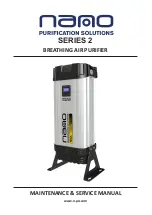
AA
10
Performing leak test & insulation
To identify potential gas leaks on the indoor unit, inspect the connection area
of each refrigerant pipe using a leak detector for R410A.
Before recreating the vacuum and recirculating the refrigerant gas, it is
advisable to pressurize the whole system with nitrogen (using a cylinder with
pressure reducer) at a pressure above 40 bar in order to immediately detect
leaks on the refrigerant fittings.
Made vacuum for 15 minutes and pressurising system with nitrogen.
Once you have checked that there are no leaks in the system, you can insulate the piping and hose.
1 To avoid condensation problems, place T13.0(0.51") or thicker Acrylonitrile
Butadien Rubber separately around each refrigerant pipe.
2 Wind insulating tape around the pipes and drain hose avoiding to compress
the insulation too much.
3 Finish wrapping insulating tape around the rest of the pipes leading to the outdoor unit.
4 The pipes and electrical cables connecting the indoor unit with the outdoor
unit must be fixed to the wall with suitable ducts.
5 Select the insulation of the refrigerant pipe.
X
Insulate the gas side and liquid side pipe referring to the thickness
according to the pipe size.
X
*OEPPSUFNQFSBUVSFPG¡$ ¡'BOEIVNJEJUZPGMFTTUIBOJTUIFTUBOEBSEDPOEJUJPO
If installing in a high humidity condition, use one grade thicker insulator by referring to the table below.
If installing in an unfavorable conditions, use thicker one.
X
*OTVMBUPSTIFBUSFTJTUBODFUFNQFSBUVSFTIPVMECFNPSFUIBO¡$ ¡'
.
t *GUIFQJQFTSFRVJSFCSB[JOHFOTVSFUIBU0'/ 0YZHFO'SFF/JUSPHFOJTøPXJOHUISPVHIUIFTZTUFN
Leak test
Insulation
/PHBQ
/#3 5 PSUIJDLFS
Insulation cover pipe
Indoor unit
Be sure to overlap
the insulation
Insulation pipe
t .VTUöUUJHIUMZBHBJOTU
body without any gap.
t "MXBZTNBLFUIFTFBNPGQJQFTGBDFVQXBSET
t "MMSFGSJHFSBOUDPOOFDUJPONVTUCFBDDFTTJCMFJOPSEFSUPQFSNJU
either unit maintenance or removing it completely.
t 5IFJOTVMBUJPOIBTUPCFQSPEVDFEJOGVMMDPNQMJBODFPG&VSPQFBO
SFHVMBUJPOSFH&&$&6UIBU
requires the use of sheaths insulation form without using CFC and
HCFC gases for health and the environment.
Pipe
Pipe size
*OTVMBUJPO5ZQF )FBUJOH$PPMJOH
Remarks
(FOFSBM
<¡$ ¡'>
High humidity
<¡$ ¡'PWFS>
&1%.̓/#3
mm
inch
mm
inch
mm
inch
Liquid
pipe
_
_
9
3/8
9
3/8
Heating resisting temper
BUVSFPWFS¡$ ¡'
_
_
13
1/2
13
1/2
(BT
pipe
1/4
13
1/2
19
3/4
_
_
19
3/4
1
_
_
19
3/4
32
1 1/4
2
1
38
1 1/2
Summary of Contents for PC4SUSMB
Page 1: ......
Page 30: ...DB68 03760 05...











































